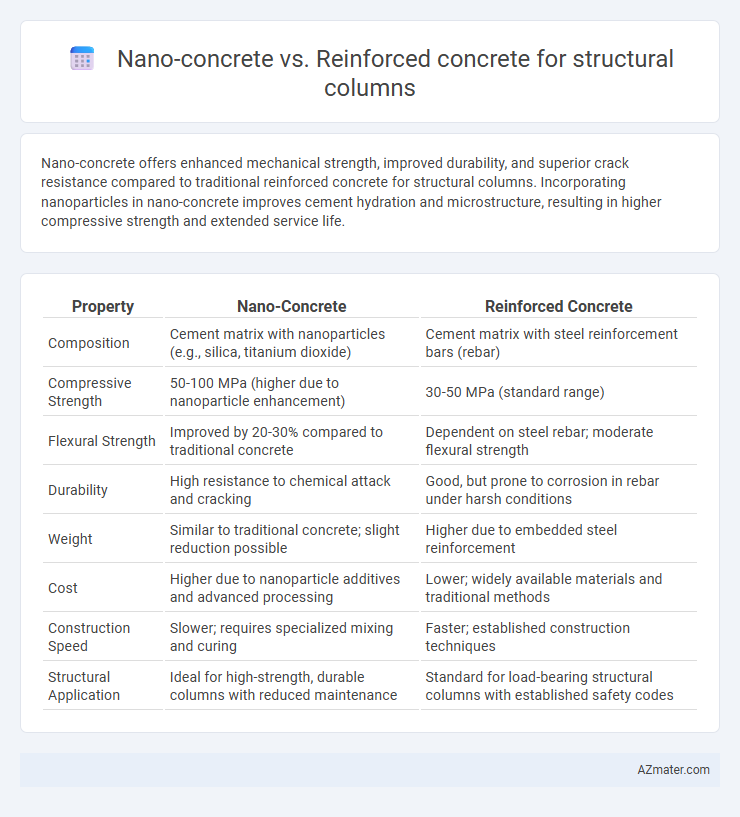Nano-concrete offers enhanced mechanical strength, improved durability, and superior crack resistance compared to traditional reinforced concrete for structural columns. Incorporating nanoparticles in nano-concrete improves cement hydration and microstructure, resulting in higher compressive strength and extended service life.
Table of Comparison
| Property | Nano-Concrete | Reinforced Concrete |
|---|---|---|
| Composition | Cement matrix with nanoparticles (e.g., silica, titanium dioxide) | Cement matrix with steel reinforcement bars (rebar) |
| Compressive Strength | 50-100 MPa (higher due to nanoparticle enhancement) | 30-50 MPa (standard range) |
| Flexural Strength | Improved by 20-30% compared to traditional concrete | Dependent on steel rebar; moderate flexural strength |
| Durability | High resistance to chemical attack and cracking | Good, but prone to corrosion in rebar under harsh conditions |
| Weight | Similar to traditional concrete; slight reduction possible | Higher due to embedded steel reinforcement |
| Cost | Higher due to nanoparticle additives and advanced processing | Lower; widely available materials and traditional methods |
| Construction Speed | Slower; requires specialized mixing and curing | Faster; established construction techniques |
| Structural Application | Ideal for high-strength, durable columns with reduced maintenance | Standard for load-bearing structural columns with established safety codes |
Introduction to Nano-Concrete and Reinforced Concrete
Nano-concrete incorporates nanoparticles such as nano-silica or nano-titania to enhance the microstructure, increasing strength, durability, and resistance to environmental degradation in structural columns. Reinforced concrete combines concrete with steel reinforcement bars to improve tensile strength, ensuring load-bearing capacity and flexibility in structural columns. Both materials are essential in modern construction, with nano-concrete offering advanced performance at the nanoscale and reinforced concrete providing proven mechanical stability.
Material Composition and Innovations
Nano-concrete incorporates nanoparticles such as nano-silica and nano-titanium dioxide into its cement matrix, enhancing density, strength, and durability compared to traditional reinforced concrete, which relies primarily on coarse aggregates and steel reinforcement bars for structural support. Innovations in nano-concrete focus on improved microstructure through the reduction of porosity and crack propagation, resulting in superior mechanical properties and enhanced resistance to environmental degradation. Reinforced concrete remains widely used due to its cost-effectiveness and established performance, but nano-concrete's material advancements offer promising potential for longer-lasting, high-performance structural columns in demanding construction environments.
Mechanical Properties Comparison
Nano-concrete exhibits superior mechanical properties compared to reinforced concrete for structural columns, including higher compressive strength ranging from 70 to 120 MPa due to the enhanced bonding between nano-sized particles and the cement matrix. Its increased tensile strength and improved modulus of elasticity result in better load-bearing capacity and resistance to cracking. The integration of nanoparticles like nano-silica and carbon nanotubes refines the microstructure, significantly enhancing durability and mechanical performance over conventional reinforced concrete.
Durability and Longevity
Nano-concrete exhibits enhanced durability due to its refined microstructure and improved nanoparticle distribution, resulting in higher resistance to cracking, chemical attacks, and environmental degradation compared to traditional reinforced concrete. Reinforced concrete, while strong in load-bearing capacity, often faces issues like corrosion of steel reinforcement and microcracking over time, which can compromise its longevity. The use of nanomaterials in nano-concrete increases tensile strength and reduces permeability, significantly extending the structural lifespan of columns in harsh or aggressive environments.
Structural Performance in Columns
Nano-concrete exhibits enhanced structural performance in columns due to its superior compressive strength, improved microstructure, and increased durability compared to traditional reinforced concrete. The incorporation of nanoparticles leads to refined pore structure and reduced microcracking, resulting in higher load-bearing capacity and better resistance to environmental degradation. Reinforced concrete columns, while effective under standard conditions, typically show lower resilience to stress concentration and durability challenges compared to nano-concrete counterparts.
Cost-Efficiency Analysis
Nano-concrete offers enhanced durability and strength at a lower material volume, reducing overall raw material costs compared to traditional reinforced concrete used in structural columns. The incorporation of nanomaterials improves crack resistance and longevity, leading to decreased maintenance and repair expenses over the column's lifecycle. While initial production costs may be higher for nano-concrete, the long-term cost-efficiency analysis favors nano-concrete due to its superior performance and extended service life in structural applications.
Construction Techniques and Workability
Nano-concrete features enhanced workability and faster curing times due to the integration of nanoparticles, which improve the matrix's homogeneity and reduce micro-cracking. Reinforced concrete relies on steel reinforcement for tensile strength but typically requires more complex formwork and longer curing periods, impacting construction speed. The nanoparticle additives in nano-concrete enable easier mixing and pumping processes, resulting in more efficient construction techniques for structural columns.
Environmental and Sustainability Impact
Nano-concrete enhances environmental sustainability by reducing raw material consumption and increasing durability, which leads to longer structural lifespan and less frequent repairs compared to traditional reinforced concrete. The integration of nanoparticles improves mechanical properties and decreases permeability, minimizing carbon dioxide emissions associated with maintenance and reconstruction. Reinforced concrete, while widely used, has a higher carbon footprint due to the extensive use of steel reinforcement and cement, both of which contribute significantly to greenhouse gas emissions.
Case Studies and Real-World Applications
Nano-concrete exhibits superior compressive strength and durability compared to reinforced concrete in structural columns, as demonstrated in case studies from seismic zones where nano-silica additives enhanced crack resistance. Real-world applications in high-rise buildings show nano-concrete columns achieving up to 30% higher load-bearing capacity with reduced material usage. Comparative analyses indicate that nano-concrete also improves corrosion resistance of embedded reinforcement, extending the lifespan of structural columns in aggressive environmental conditions.
Future Trends in Structural Column Materials
Nano-concrete enhances structural column performance through improved durability, higher compressive strength, and self-healing properties enabled by nanomaterials like nano-silica and carbon nanotubes. Reinforced concrete remains widely used but faces challenges with corrosion of steel reinforcement and environmental impact, pushing research towards integrating nanotechnology for superior resilience and sustainability. Future trends emphasize hybrid materials combining nanotechnology with traditional reinforcement to optimize load-bearing capacity and extend service life in structural columns.

Infographic: Nano-concrete vs Reinforced concrete for Structural column
 azmater.com
azmater.com